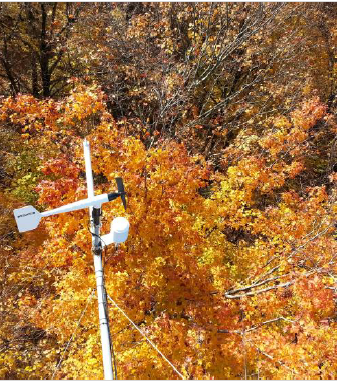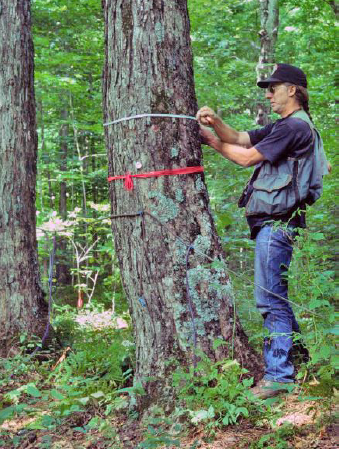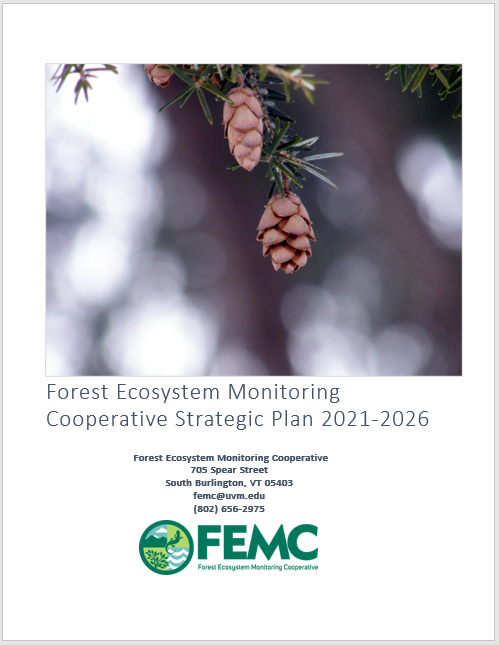The Forest Ecosystem Monitoring Cooperative Strategic Plan 2021-2026 guides the work of the Cooperative staff and key partners to meet the mission and achieve the vision of the Cooperative’s governing bodies. This plan represents a fresh look at the role of the FEMC as a seven-state regional entity supporting state, federal, non-profit, private-sector and academic partners in monitoring and reporting on the conditions of the region’s forests.
The FEMC Mission
To serve the northeast temperate forest region through improved understanding of long-term trends, annual conditions, and interdisciplinary relationships of the physical, chemical, and biological components of forested ecosystems.
The FEMC also promotes the efficient coordination of multi-disciplinary environmental monitoring and research activities among federal, state, university, and private-sector agencies with common interests in the long-term health, management, and protection of forested ecosystems.
The FEMC Vision
A diverse network of public and private partners, residents, and communities in the Northeast have access to reliable knowledge, data, support, and network connections they need. They use this knowledge to sustain more resilient and healthy forest ecosystems and communities.
Goals and Objectives of the Forest Ecosystem Monitoring Cooperative
1

FEMC fills an essential niche by providing long-term, reliable and professional coordination that supports monitoring and research activities in the region across federal, state and private-sector agencies, organizations and institutions. This role at the regional scale builds upon 26 years of success in Vermont in maintaining this focus and funding to perform this service. In today’s funding environment it is more important than ever to minimize duplication of effort and to leverage available funding to provide the data and information necessary to inform policy and management decisions affecting the forested landscapes of our region. Through its annual conferences, data archive, website, workshops and other information outlets, FEMC consistently provides important information about forest ecosystems to land and resource managers, decision-makers, cooperators, researchers and the public.
Three objectives have been defined under Goal 1:
Objective 1.1Provide regular opportunities for networking across disciplines and organizations
Objective 1.2Coordinate efforts around high priority issues to produce integrated products
Objective 1.3Provide a forum to inform future activities among partners
2

FEMC cooperators and stakeholders have repeatedly identified the value added by FEMC through post-collection data analyses, synthesis and reporting, and that these services allow them to do their jobs better. FEMC has allocated increasing amounts of staff time and resources for these ventures, both to do novel analysis and to develop tools and products that enable people to access and better understand information.
FEMC (and the VMC before it) periodically produce integrated data summaries and synthesis reports, acting as the coordinating organization that brings together cooperators and experts interested in working on the report. FEMC also continues to expand its role in producing data portals, online data integration and discovery tools, and other products that provide both information and context as well as access to raw data, methods and findings. Some examples include the Vermont Forest Indicators Dashboard, the Northeastern Forest Health Atlas and the Northeastern Forest Regeneration Data Network. This collection of tools and products represent a significant offering for partners in the region for going beyond data access and providing tools for integration and understanding.
Underlying FEMC’s data synthesis and integration work is the FEMC Data Archive, which provides data storage and access infrastructure to the Cooperative free of charge. This repository of data and information about how the data was collected serves a critical need in the region by housing both monitoring and research data that might otherwise be lost or extremely difficult to access. FEMC’s Data Archive continues to be a critical component of making information and data accessible and usable.
Two objectives have been defined under Goal 2:
Objective 2.1Facilitate the development and distribution of FEMC data syntheses
Objective 2.2Provide state-of-the-art tools for preserving, accessing and exploring data
3


The Forest Ecosystem Monitoring Cooperative is premised on the recognition that long-term environmental monitoring and research are essential to collecting the baseline data needed to detect changes in conditions and trends and help identify new threats to our forested ecosystems. Long-term environmental monitoring has been a hallmark of the FEMC and VMC since its inception. FEMC has maintained a significant commitment to and history of continued support for monitoring and research projects over this duration.
FEMC has a long history of supporting monitoring in Vermont, and these long-term records have allowed our cooperators to detect changes in forest phenology, trends of bird, amphibian and reptile populations, and changes in forest tree species distributions and growth rates and. As the scale of environmental challenges grows increasingly complex, these records in Vermont complement other long-term monitoring efforts across the region, and the FEMC can support and coordinate these important data collections in Vermont, as well as providing secure archiving and widespread distribution of the data.
In addition, FEMC has expanded monitoring across the region through expanded forest health monitoring network, funding for new data collections in partnering states, and, most recently, the launch of an Ecosystem Monitoring and Assessment Fund. In combination with the extensive monitoring of partners, FEMC is poised to maintain a valuable suite of monitoring in the region that will support tracking and reporting on change over time.
Two objectives have been defined under Goal 3:
Objective 3.1Maintain long-term monitoring activities
Objective 3.2Monitor and report on current environmental conditions and potential threats
Activities that Support Goals and Objectives
The Forest Ecosystem Monitoring Cooperative is designed to service the needs of a wide array of partners. To that end, the organization pursues thirteen activities to accomplish its goals and objectives. Each activity supports one or more goals or objectives. The specific goals and objectives supported by each activity are outlined below.
| Activity | Objectives Supported |
|---|---|
| Maintain a committee structure that directs FEMC efforts and enables networking and collaboration across states, organizations, and disciplines | 1.1, 1.2, 1.3 2.1 |
| Regularly convene collaborators to identify priority issues, information gaps, opportunities, and critical needs across the region. | 1.1, 1.2, 1.3 3.2 |
| Regularly convene environmental professionals at an annual meeting to share information and enable networking | 1.1, 1.3 2.1 3.2 |
| Support monitoring, integration, and synthesis efforts that further FEMC’s mission and priority topic areas | 1.2 2.1, 2.2 3.1, 3.2 |
| Promote the utility of FEMC products developed through state and regional work to other stakeholders in the region | 1.2 2.1 3.2 |
| Develop, execute, and monitor the success of a communications and engagement strategy that distributes information to and solicits input from collaborators | 1.2, 1.3 2.1, 2.2 3.2 |
| Provide data management and analytical services to states and the broader collaborative network via service agreements | 2.2 |
| Maintain and improve the FEMC data archive as a regional resource | 2.1, 2.2 3.1 |
| Provide online tools, dashboards, and collections to facilitate data access and interpretation | 1.2 2.1, 2.2 3.2 |
| Provide training workshops on FEMC tools to expand the use and contribution of data | 2.1, 2.2 3.1, 3.2 |
| Maintain support, tracking, and utilization of monitoring efforts across the region | 1.2 2.1 3.1 |
| Summarize current conditions and long-term trends for key long-term datasets | 1.2 2.1 3.2 |
| Provide annual report for wide dissemination of FEMC activities, accomplishments, and impacts | 1.2, 1.3 2.1 3.2 |

